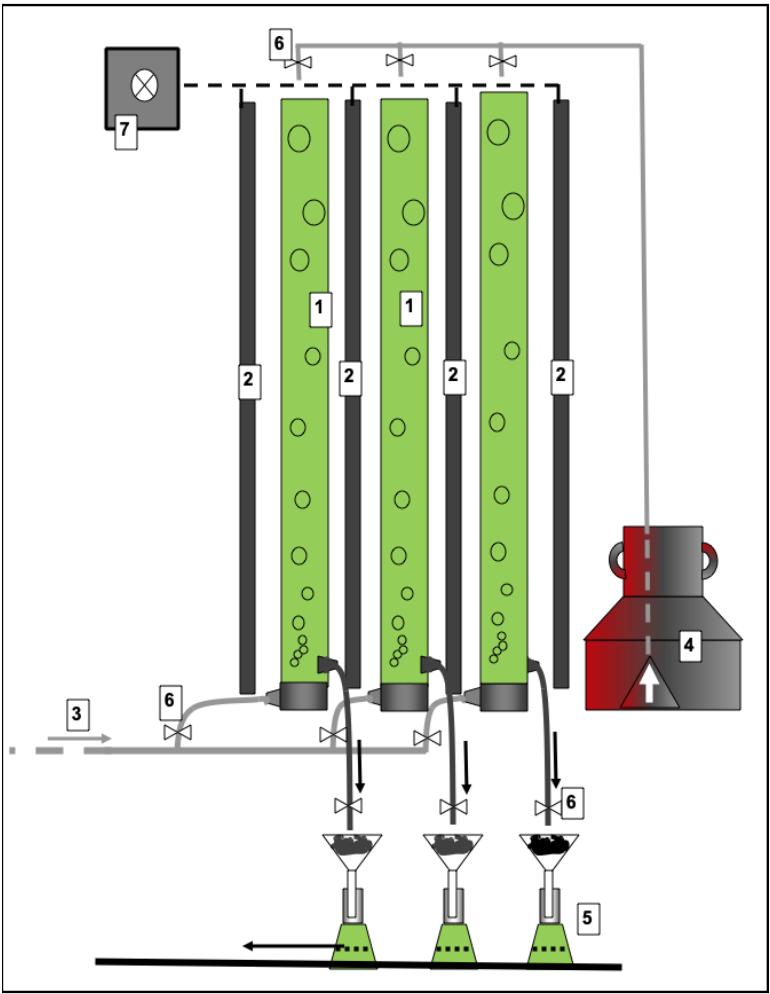Photobioreactors for wastewater treatment and power generation

Many recent studies have shown that microalgae cultivation is the key to the solution of many environmental problems: from biofuel production and nutrient removal from wastewater to utilization of greenhouse gases. Despite the fact that photobioreactors have the ability to treat urban wastewater, we decided to experience first-hand how minute microalgae can help to do the same thing.
Urban wastewater treatment facilities such as Kuryanovo Wastewater Treatment Plant (KWWTP) are responsible for the treatment of incoming wastewater from population (to a greater extent) and from industries (to a lesser extent) so that treated water can be discharged into natural water bodies. Apart from traditional treatment technologies (grids, filters, settling tanks, separators, precipitation tanks), biological treatment is also applied, usually by means of activated sludge. Alternatively, we offered the cultivation of green microalgae: as they grow in special devices (photobiorectors), they feed on those very nutrients which have to be removed from wastewater.
Using microalgae has a whole range of advantages (compared to activated sludge): no waste is produced; the obtained biomass can be used for biogas production or you can sell it as a fertilizer, a raw material for biofuel or as a source of valuable elements.
For our experiment we have developed from scratch a new photobiorector, fine-tuned its optimum performance on the basis of influent flow data and requirements to effluent flow (treated water). We have also studied and obtained excellent data on the possibility of using cultivated biomass for biogas generation.

Diagrams and figures speak for themselves.
Removal efficiency by two main monocultures (Scenedesmus and Chlorella) cultivated in untreated water (wastewater) achieved up to 86% (for ammonium) and up to 50% (for nitrates).

Figure 1. The main indicators of the photobioreactor for different VER:
1) Total nitrogen and phosphate removing efficiency, %,
2) Biomass productivity, mg/l/day.
Another worth mentioning advantage is wastewater purification from bacterial contamination: E.coli, coliform bacteria and other sanitary indicators. Removal efficiency of wastewater in the photobioreactor with algae was 99%.
If you want to get biogas from activated sludge fermentation, you have to maintain a certain proportion of inoculum and substrate and also to control a set of parameters such as ammonium ion content, otherwise there is a risk of getting biogas with degraded characteristics. If you use microalgae as inoculum there is no risk involved. The composition of the obtained biogas will be always relatively fixed.
Analysis of influent and effluent wastewater, development of a proper operating model of an industrial photobioreactor and solution of related tuning problems, dynamic selection of microalgal cultures, overall cost analysis on scheme preparation, forecast and actual efficiency analysis of the implemented treatment system, justification of technological advantages over current treatment systems, calculation of the received biofuel after treatment, etc. All of these problems are being solved within the framework of this project.
Full Text:
Shchegolkova, N., Shurshin, K., Pogosyan, S., Voronova, E., Matorin, D., & Karyakin, D. (2018). Microalgae cultivation for wastewater treatment and biogas production at Moscow wastewater treatment plant. Water Science and Technology, wst2018088. doi:10.2166/wst.2018.088
